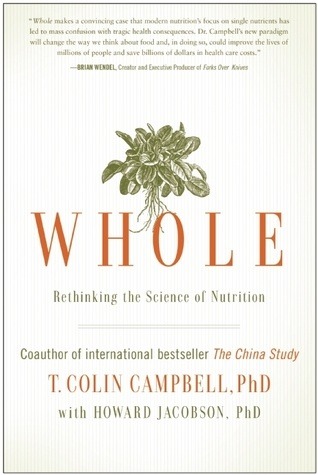More on this book
Community
Kindle Notes & Highlights
Read between
March 4 - March 11, 2018
Eat a variety of vegetables, fruits, raw nuts and seeds, beans and legumes, and whole grains. Avoid heavily processed foods and animal products. Stay away from added salt, oil, and sugar. Aim to get 80 percent of your calories from carbohydrates, 10 percent from fat, and 10 percent from protein.
So how might a plant-based diet protect us from the disease-causing effects of free radicals? For one thing, there is some evidence that high-protein diets enhance free radical production, thus encouraging unwanted tissue damage.
When I say “protein,” what foods do you think of? Probably not spinach and kale, although those plants have about twice as much protein, per calorie, as a lean cut of beef.
We’ve found that cancer growth is controlled far more by nutrition than by genes, which is outside of the scientific paradigm.
Another example of an outlier that led me away from “accepted wisdom” was our finding that casein, which for decades had been the most highly rated and respected protein, dramatically and convincingly promoted cancer. Even today, it is so heretical that no one wants to say the obvious—that casein is the most relevant chemical carcinogen ever identified.
If you are a reductionist, you believe that everything in the world can be understood if you understand all its component parts. A wholist, on the other hand, believes that the whole can be greater than the sum of its parts. That’s
The history of the last 200 years has been the inexorable march of reductionism in all aspects of our lives, from science, to nutrition, to education (think of all the “subjects” taught in isolation from one another), to economics (think of microeconomics versus macroeconomics), and even the human soul (think of how it has been reduced to a map of nerves and networks in the brain).
And since one of the main outputs of metabolism is usable energy for the body, it’s crucial that the energy produced be greater—by a wide margin—than the energy expended to produce it. Fortunately, we’ve evolved molecules whose main job is to significantly lower the energy required for chemical reactions within the body. These molecules are called enzymes.
He estimates that animal-based food requires about five to fifty times more land and water resources than the same number of calories of plant-based food (depending on various considerations, including animal species and whether the animal is pasture fed). In a world where human hunger is endemic, this inefficient use of resources is a tragedy.
The story gets worse! Big Pharma also inflates the interest rate they use to determine the cost of capital and ignores substantial tax savings related to R&D and their foreign tax havens. Those lost taxes, according to Light and Warburton, “might pay for nearly all pharmaceutical R&D costs.”
As we’ve seen, a technological approach to nutrition—the kind that makes money for industry—includes drugs, supplements, and enriched and fortified foods. All of these are highly profitable and protected by intellectual property laws. There’s plenty of funding for this type of science, and so plenty of it gets done.
By contrast, research into the nutritional effects of whole plant foods doesn’t really have market potential. You can’t patent a recommendation to eat lots of fruits, vegetables, nuts,
seeds, and whole grains. So there’s no incentive for industry to invest in such research and no incentive for researchers...
This highlight has been truncated due to consecutive passage length restrictions.
There is impressive evidence that high levels of milk consumption correlate with high rates of MS prevalence, and long-term studies show much lower death rates among MS patients who ate a plant-rich diet (5 percent, compared with 80 percent for those who consumed an unhealthy diet).11


